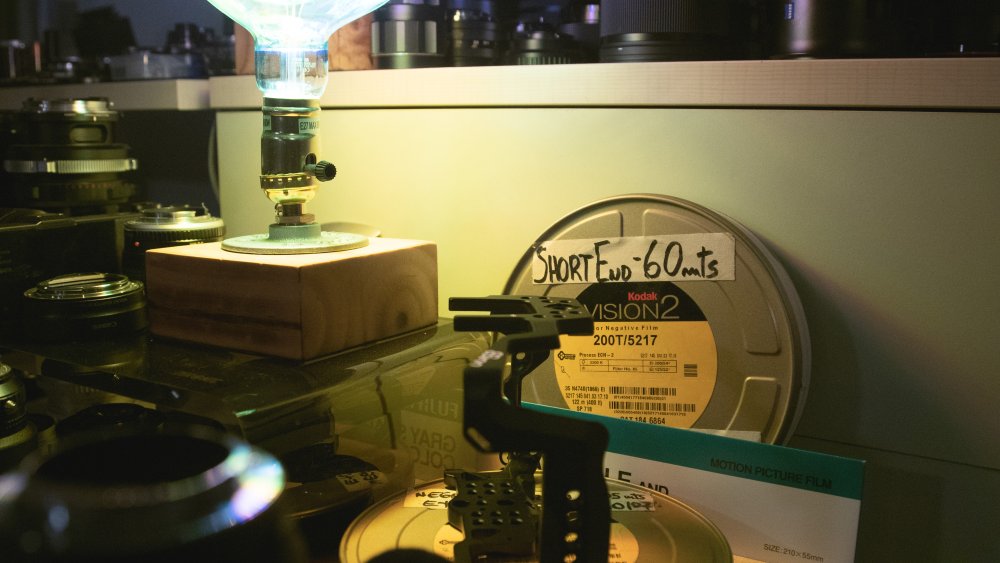Leaderboard
Popular Content
Showing content with the highest reputation on 10/25/2022 in all areas
-
I wouldn't worry too much about the stills capabilities of a camera (unless you're a very serious professional photographer, in which case you've likely already got firm opinions on what camera to get and not asking here), because long long ago cameras already reached the level of "good enough" for professional work for the vast majority of professional photographers. While it has taken much longer for hybrid cameras to reach that point of "good enough". (I'd say that's only just now happening, now that many are getting 10bit internal) Thus even if you got a very video focused camera (such as a P4K / C70 / FX30 / etc) then you could just for cheap buy a stills camera to use alongside your main camera that's for video. As in my opinion even an old Nikon D700 (only a couple of hundred dollars secondhand!) is "good enough" for the majority of "professional photographers" out there. (unless you're more into say the sports photography niche, in which case a cheap Nikon D500 still is one of the very best you could go for) So if you for instance decided to go with a P4K as your filming camera, you could grab a Panasonic G7 to complement it for stills. Or a cheap Sony a6000 to complement the FX30 for stills. (I disagree about sensor size when it comes to shooting though, and people should just choose the right lens for the job. But anyway... you could say get a cheap cheap Sony a7mk1 for your stills, to use alongside an FX30? Or go nuts with resolution and get a Sony a7Rmk1? There is one on eBay at the moment for US$500)3 points
-
Fuji X-H2 in the house
Juank and 2 others reacted to Dustin Jenkins for a topic
Here is a link to all the footage. All shot with the xf 23mm f1.4 R LM WR at F4. Iso was at the base iso for each respective flog 2 and the shutter speed was changed to get similar exposure. NR and Sharpening at -4 and no interframe NR. Video levels for Prores and full range for HEVC. Files are named what they are, e.g. XH2 PRHQ is Prores HQ shot on the x-h2. https://drive.google.com/drive/folders/1h7OQtCirDoy9fcxxZaIDBxlJOPEn-Dcx3 points -

Deciding closest modern camera to Digital Bolex look
kaylee and one other reacted to Andrew Reid for a topic
It is interesting that Joe says in the video, they wanted the absolute character of the Kodak sensor to be preserved in-camera, without any noise reduction or introduction of any circuit noise. Just the natural grain from the sensor. So it got me thinking... With HVEC and modern sensors we have a squeaky clean look. It has a lot of noise reduction you can't turn off, and a lot of compression. So if we wanted the colour, character, uncompressed Cinema DNG and film grain of the Digital Bolex... We need to find a modern camera... Because the D16 on eBay now is $6K!! I think the closest I own is the Sigma Fp-L in crop mode. It has the resolution for 2x crop so works with Super 16mm lenses. But any crop from about 1.37x onward gives a very detailed texture to the uncompressed 4K raw.... as it is a 1:1 pixel readout. If you download the frame grab below, and look at the full 4K JPG conversion of my DNG, it is apparent at 1:1 that nothing is being lost and nothing is being added. Especially since this is at ISO 3200 behind a strong ND filter. At lower ISOs it looks a bit too clean to be a Digital Bolex-a-like. However at ISO 3200 it is perfectly on note. What other cameras could we wrangle (with a few tricks) to look like a Kodak CCD? GH5S? S1R 5K? Canon RAW? Nikon Z9? How about our smartphones in Motion Cam?2 points -

Bitrates. Where do you draw the line?
John Matthews and one other reacted to Andrew Reid for a topic
Remember when the 1D C came out, with MJPEG 4K. 500Mbit/s file sizes were a real struggle in a practical sense. Now we have this enormous range, anything from 100Mbit H.264 to 3000Mbit RAW. I am interested what kind of file sizes people are comfortable with and using most in 2022. Do you find yourself sticking with smaller file sizes like 200Mbit H265? Would you shoot much ProRes 422 HQ if you had a Nikon Z9 (2700Mbit)? If so what are you editing from (HDD or SSD?) and archiving master files with? Looking forward to hearing from you all. Just for reference. Here's what I think... - Best overall codec is ProRes 422 LT in 4K oversampled from 8K on X-H2. 435Mbit and image quality is flawless - Bitrate sweet spot for me is around 200Mbit. I find that kind of file size nice and manageable over time. Anything bigger is more of a special occasion thing. - I don't mind 8bit at all as long as it has some colour science mojo going on - ProRes 422 HQ in GH6 and Nikon Z9 is too big, not practical in my opinion - may as well shoot raw? - HVEC on S1 and S1R has some very nice mojo going on and tiny file sizes so a thumbs up to them. - I don't shoot BRAW, prefer Cinema DNG on Sigma Fp-L. Special occasions only but great for pulling stills from a short burst at 24fps.2 points -
I get where you’re getting at with your suggestion as I use a variety of different cameras for stills ranging from expensive Leica M rangefinder to Yashica 35mm film point & shoot to older DSLRs and of course mirrorless. That said I can understand someone with perhaps less experience and funds simply wants one camera body and one lens system. That’s a good place to start too. The EOS R is actually a very decent hybrid despite all the hate it garnished at its release due to the massive 4K crop. It sounds like you enjoy Canon ergonomics, color science, value their AF system and your invested in their lenses. This begs the question, why go through the hassle of changing systems? And why even consider Panasonic if AF is important to you? FYI, I was also an EOS R user with just the 35mm RF and EF lenses and I chose to upgrade to R6 two years ago. Its a massive upgrade as you gain IBIS, oversampled 4K with no crop, 10-bit codec, Clog3 & DPAF2 with eye tracking. It’s a bit of a no brainer if you’re looking to upgrade from an EOS R in that $2K budget. Although the overheating may make that a big no-go in that tropical Brazilian heat. in that case maybe smart to wait for R6 mk2 that appears to be right around the corner. or switch to Sony or Nikon if you can’t wait and wanna stay FF and have great AF. I’d only consider Panasonic if your planning on shooting video with manual lenses..2 points
-
heres a fun thread! my current playlist includes helping build haunts (!!!), shopping for trashy halloween store stuff aaaanndd • horror movies ive never really watched like Exorcist 3 or Halloween 18, whatever • fav 'horror' movie of all time is the shining btw lol (sort of doesnt count?) • maybe ill watch Alien... • Simpsons treehouse of horror seasons 1-10+ • x files monster of the week episodes • Anything Ghost podcast • Garfield halloween (garfield sucks but i have a soft spot for him. not funny but kinda sweet) • been watching Are You Afraid of the Dark? vintage nick, never seen it before • do you know whats ACTUALLY p darn good? dahmer on netflix. check it out..... IF YOU DARE MUAHHAHAHHAAAAA • oh, and of course GHOST TO GHOST AM with art bell what are you watching/doing? costumes? haunts?? projection mapping the house??? give me stuff to watch1 point
-
Funny you say it's collecting dust, I'm considering upgrading to a Panasonic S1 from my Nikon Z6. You selling? Just curious.1 point
-
Deciding closest modern camera to Digital Bolex look
PannySVHS reacted to newfoundmass for a topic
That entire series is excellent, especially that entry. What about one of the older BM cameras?1 point -

Bitrates. Where do you draw the line?
solovetski reacted to John Matthews for a topic
But Kye, the human eye has evolved, you see. What was more than adequate in 2015 is no longer going to cut the mustard in 2022. Funny how things have changed.1 point -

Topaz Video Ai (version 3.0)- any good?
newfoundmass reacted to John Matthews for a topic
Me too. I have a bunch of family footage. It doesn't look too bad just on my iMac M1, but upon de-interlacing, it really came to life and it looked like how I remember it. I'd also agree by saying it look close to consumer-grade 1080p.1 point -

Fuji X-H2 in the house
kye reacted to Andrew Reid for a topic
What's interesting is that the Digital Bolex used a completely separate board for the Kodak CCD sensor internally. This was to avoid introducing noise which would need cleaning up and it is that step in the pipeline that hurts the nuances of a sensor according to Joe Rubinstein. So it might be that with the modern cameras and their single circuit board, there's simply too much pre-processing going on and too much interference with the signal coming back off the sensor, which lends more digital look. It would be lovely to get the look of a Digital Bolex in a modern mirrorless camera. We'll see if we can harangue the X-H2 into looking more 'raw'.1 point -
I'm talking acquisition from a DPs perspective. As the following video from 2014 states, 80% of films back then where shot above 3K yet indeed 99% were finished in 2K. That doesn't mean it was ideal as far as IQ as the guy explains nobody printed Super35 to Super16 which is sort of what was being done back then. Not to mention they were already anticipating 4K streaming (or "broadband" as they called it then lol). He goes on to explain/push the benefits of shooting in ARRIRAW at 3.4K with the then new XT and details a workflow where you'd transcode to ProRes 444 2.8K for a 50% gain in file size and almost 3K resolution. That would have definitely been the forward-thinking workflow:1 point
-

Fuji X-H2 in the house
Juank reacted to Andrew Reid for a topic
https://we.tl/t-ZnnuboUFed That's another X-H2 ProRes 422 HQ clip in 8K (FLOG 2) Autumn trees at infinity Will be interesting to see how (or if) the processing has changed1 point -
I'm shooting H.265 200 Mbit on the X-T4 and used to shoot 150 Mbit H.265 on the GH5. I fully accept the weaknesses of those codecs, but I create only content for social media or personal usage so there is absolutely no point in recording in higher bit rates or codecs. Most people are obsessed with technical image quality when in the end, anyway no one cares about their results (cat video on YT with 7 views). The only moment where I might use a higher bit rate option is if I record something with water, because that's always a disaster in LongGOP. I always used to transcode to ProRes and wanted a camera that can record ProRes because of my editing system, but since I switched to Apple M1 based hardware, everything is golden with H.265.1 point
-

Bitrates. Where do you draw the line?
kye reacted to The Dancing Babamef for a topic
Yes. but I also think that having high bitrate for 10bit 422 will account for the missing information in color, comparing to 444. But all of this circles back to the use case: are you filming a talking head or in a forest with lots of trees and moving micro elements that take up the bitrate so even thou the files are large it's justified as the utilization is high. But just like Andrew said in the original post: "- ProRes 422 HQ in GH6 and Nikon Z9 is too big, not practical in my opinion - may as well shoot raw?" Go watch DpReview's episodes and ProAV TV. Their shows might as well be audio only except the actual image comparisons.1 point -
Good observations. I agree that h264/h265 can really kill footage with sharpening & NR done in-cam. But it really depends on camera brands and models. Even within Sony, the FX3/A7S3 has tons of NR you can't adjust. The same sensor on FX6 is a lot more adjustable and on the new FX30 the same XAVC codecs display much less NR applied in-cam so it seems Sony listened to feedback. Canon allow you to fully turn off high ISO NR. And higher end models have internal compressed RAW. On Fuji you can reduce NR & sharpening but not fully turn off. Now with ProRes I assume there is a less processed image but its still a baked in format so not sure of the specifics. All-in-all prosumer hybrid cameras are getting better with XH2/XH2S/GH6/Z9 taking the lead with internal Prores. Followed by Canon with internal RAW. Sony is really still in last position with its heavy NR induced h26x codecs.1 point
-
If you're referring to the Alexa Classic, 2K ProRes HQ was closer to 300Mbps and it could shoot up to 430Mbps in 4444. Second gen Alexa XT really changed the game though with ARRIRAW /Prores XQ and resolutions up to 3.4K in OpenGate. So I'd say "sufficient" by 2010 theatrical standards but ARRI IQ took a major bump as soon as the XT came out around 2013. Besides I heard there were software upgrades to give the Classic 3.2K/3.4K XQ/Open Gate so those bitrates and resolutions may have been used much earlier than 2013. Long story short I don't know if that many features were actually shot in 2K ProRes HQ..1 point
-

Bitrates. Where do you draw the line?
John Matthews reacted to kye for a topic
This raises an interesting question for me about what role resolution plays in the quality of Prores. Prores bitrates scale proportionally with resolution, so 4K is ~4x the bitrates of 1080p because there are ~4x the pixels. I would assert that 2K Prores HQ is "sufficient" (not perfect, but sufficient) as countless feature films were shot in 2K/1080p Prores HQ (at ~180Mbps) and were projected in theatres worldwide on the largest screens available (short of IMAX), so the macro-blocking can't have been too bad. So then, if we're talking 4K, Prores HQ is ~700Mbps and LT is ~330, which is almost double the 2K HQ bitrate. If you film 4K you don't project it onto a larger screen just because you have more bitrate (plus there aren't really many screens larger than real cinemas anyway), so even if the macro-blocking is larger from LT in terms of how many pixels wide the artefacts are, the fact that there's more bitrate for the whole image, surely the artefacts would be less visible than on 2K HQ? Does anyone know how this comparison actually fares in the real world? I've never tested this particular aspect.1 point -
..if you need AF though Panasonic is probably the worst system of the bunch and a huge downgrade from Canon. Image quality means nothing if you can't hold focus. Best bang for buck is probably XH2 right now. 45MP stills. 8K, 10-bit, ProRes. Phase-detect AF with eye detect. Film simulations. FX30 also super solid for run & gun. Oversampled 4K. AF on par with Canon. 4K120p. 10-bit. LUT support. Top handle with XLRs. But yeah, switching systems is expensive so if you own a lot of lenses probably better to wait for suitable model than switch. APS-C / Super35 seems to be where it's at right now as far as bang for buck in the $2K bracket.1 point
-
I would suggest the same and go with the Panasonic S5. Best in class overall image quality, good battery life, great body. Price is hard to beat. Price vs quality ratio is by far the best. The image trumps all other contenders and is only equalled by the R5 or Z9 in its Raw modes and even that is trumped in lowlight. Best reasonable update. Period. Look no further if i need now. If not in need, keep using what you got I guess. Which is never the worst thing to do and often a good idea. 🙂1 point
-
Topaz Video Ai (version 3.0)- any good?
John Matthews reacted to newfoundmass for a topic
I've been using it for about a year now and some of the results are genuinely astonishing. I just got the update, too, and have been impressed. On my M1 Pro MacBook Pro it does about 10fps, so it's not TOO bad, especially if you come from the days when it'd take hours to render stuff. I mostly use it to upscale old footage; decent 480i footage upscales quite nicely. I can't say that it looks like native 1080p but it's not that far. Their photo software is also very impressive, maybe even more than Video AI.1 point -

Bitrates. Where do you draw the line?
The Dancing Babamef reacted to Andrew Reid for a topic
Username checks out 😉 Honorable mention to EOS R3 with 6K C-RAW (24.00p/23.98p): Approx. 720 Mbps That it is actually quite a nice data rate for 6K RAW compared to most other cameras which are 2000Mbit+1 point




